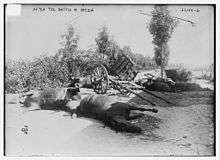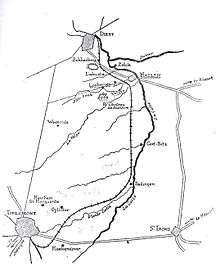Battle of Halen
| ||||||||||||||||||||||||||||||
The Battle of Halen or Haelen, was a cavalry battle at the beginning of World War I. The battle is also known as the Battle of the Silver Helmets (Dutch: Slag der Zilveren Helmen French: Bataille des casques d'argent), an analogy with the Battle of the Golden Spurs of 1302, because of the many cavalry helmets left behind on the battlefield by the German Cuirassiers.[lower-alpha 1] Halen is a small market town which was on the principal axis of advance of the Imperial German army, where there was a good crossing point over the Gete River. The battle took place on 12 August 1914, between German forces led by Georg von der Marwitz and the Belgian troops led by Léon de Witte. The battle was a tactical victory for the Belgians but did little to delay the German invasion of Belgium.
Background
On 3 August the Belgian government refused a German ultimatum and the British government guaranteed military support to Belgium should Germany invade. Germany declared war on France, the British government ordered general mobilisation and Italy declared neutrality. On 4 August, the British government sent an ultimatum to Germany and declared war on Germany at midnight on 4/5 August, Central European time. Belgium severed diplomatic relations with Germany and Germany declared war on Belgium. German troops crossed the Belgian frontier and attacked Liège.[1] A week after the German invasion, German cavalry had been operating towards Hasselt and Diest, which threatened the left flank of the army on the Gete. Belgian General Headquarters chose Halen as a place to delay the advance and make time to complete an orderly retreat to the west. The Belgian Cavalry Division was sent from Sint-Truiden to Budingen and Halen, to extend the Belgian left flank.[2]
Prelude

The German II Cavalry Corps under General Georg von der Marwitz was ordered to conduct reconnaissance towards Antwerp, Brussels and Charleroi and by 7 August, had found that the area to a line from Diest to Huy empty of Belgian and Allied troops. Belgian and French troops were rumoured to be between Tienen and Huy and Marwitz advanced to the north towards parties of Belgian cavalry, which had retired towards Diest.[3] On 11 August, large bodies of German cavalry, artillery and infantry had been seen by Belgian cavalry scouts in the area from Sint-Truiden to Hasselt and Diest. Belgian headquarters therefore anticipated a German advance towards Hasselt and Diest. To block the German advance the Belgian Cavalry Division, commanded by Lieutenant-General Léon de Witte, was sent to guard the bridge over the River Gete at Halen. During an evening meeting, the Belgian general staff convinced de Witte to fight a dismounted action, to negate the German numerical advantage.[4] General de Witte had garrisoned the Gete crossings at Diest, Halen, Geetbets and Budingen. The main road from Hasselt to Diest passed through this village, most of which was on the left bank. If captured, Loksbergen and Waanrode would be outflanked and the left wing of the Belgian army threatened. General de Witte used Halen as an outpost and concentrated a battalion of cyclist infantry and dismounted cavalry behind the village, from Zelk to Velpen and the hamlet of Liebroek, to act as a line of resistance if Halen was captured.[5]
Battle
The German cavalry did not begin to move until 12 August due to the fatigue of the horses caused by the intense summer heat and a lack of oats. The 2nd Cavalry Division of Major-General von Krane advanced through Hasselt to Spalbeek and the 4th Cavalry Division under Lieutenant-General von Garnier advanced via Alken to Stevoort. The Belgian Headquarters discovered from intercepted wireless messages that German troops were advancing towards de Witte's position and sent the 4th Infantry Brigade to reinforce the Cavalry Division. Marwitz ordered the 4th Cavalry Division to cross the Gete and at 8:45 a.m. the 7th and 9th Jäger battalions advanced.[6] A German scouting party advancing from Herk-de-Stad came under fire from Belgian troops and c. 200 Belgian troopers attempted to set up a fortified position in the old brewery in Halen but were driven out when the Germans brought up field artillery.[4]
Belgian engineers had blown the bridge over the Gete but the structure only partly collapsed and the Germans got c. 1,000 troops into the centre of Halen.[4] The main Belgian defence line was west of Halen, in terrain which gave only an obstructed view to the attacker. The 17th and 3rd Cavalry brigades assisted the Jäger in and south of Halen, which enabled artillery to be brought to the fringe of the village. Attacks into the cornfields beyond were repulsed with many casualties, some cavalry becoming trapped by wire fences.
The brigade is destroyed.... Rode in against infantry, artillery and machine-guns, hung up on the wire, fell into a sunken road, all shot down.— Maximilian von Poseck[7]
The Jäger were also repulsed despite support from the 2nd Guards Machine-gun Detachment and dismounted cavalry sharpshooters.[6] Towards the end of the day, Marwitz broke off the engagement; the 2nd Cavalry Division retired towards Hasselt and the 4th Cavalry Division withdrew to Alken.[8][6]
Aftermath

De Witte repulsed the German cavalry attacks by ordering the cavalry, which included a company of cyclists and one of pioneers to fight dismounted and meet the attack with massed rifle fire. Significant casualties were inflicted upon the Germans. The German cavalry had managed to obscure the operations on the German right flank and established a front parallel with Liège and discovered the positions of the Belgian field army but had not been able to penetrate beyond the Belgian front line and discover Belgian dispositions beyond.[8][9] Although a Belgian victory, the battle had little strategic effect and the Germans later besieged and captured the fortified areas of Namur, Liège and Antwerp, on which Belgian strategy hinged. The German advance was stopped at the Battle of the Yser at the end of October 1914, by which time the Germans had driven Belgian and Allied troops out of most of Belgium and imposed a military government.[10]
The German 4th Cavalry Division lost 501 men and c. 848 horses during the battle, casualty rates of 16 percent and 28 percent.[7] Total casualties of the 2nd and 4th Cavalry divisions were 150 dead, 600 wounded, 200–300 prisoners.[11] The Belgian army had 1,122 casualties, including 160 dead and 320 wounded.[12]
Until the German advance into France began, the 2nd Cavalry Division remained in the vicinity of Hasselt to guard the area near the Gete and the 4th Cavalry Division moved south on 13 August to the area around Loon and then moved towards the south-east of Tienen and joined the 9th Cavalry Division, which had crossed the Meuse on 14 August. On 16 August Marwitz advanced with the two divisions to Opprebais and Chaumont-Gistoux, where skirmishing with cavalry and artillery occurred, before meeting infantry who were well dug-in. Next day the cavalry slowly retired towards Hannut.[13]
Notes
- ↑ "Haelen" is the French language rendering of its local name in Dutch, "Halen", which was preferred by contemporary English speakers. Usage of Haelen, together with many other French-derived place names in Flanders, is considered archaic.
Footnotes
- ↑ Skinner & Stacke 1922, p. 6.
- ↑ Essen 1917, pp. 106–107.
- ↑ Humphries & Maker 2013, pp. 107–108.
- 1 2 3 General Staff 1915, p. 19.
- ↑ Essen 1917, p. 107.
- 1 2 3 Humphries & Maker 2013, p. 108.
- 1 2 Brose 2001, p. 190.
- 1 2 General Staff 1915, pp. 20–21.
- ↑ Humphries & Maker 2013, p. 109.
- ↑ Strachan 2001, pp. 208–224, 262–281.
- ↑ Duffy 2009.
- ↑ Essen 1917, p. 113.
- ↑ Humphries & Maker 2013, pp. 108–109.
References
- Books
- Brose, E. D. (2001). The Kaiser's Army: The Politics of Military Technology in Germany During the Machine Age, 1870–1918. London: Oxford University Press. ISBN 0-19-517945-5.
- Essen, L. J. van der (1917). The Invasion and the War in Belgium From Liège to the Yser (PDF). London: T. F. Unwin. OCLC 800487618. Retrieved 4 January 2014.
- Humphries, M. O.; Maker, J. (2013). Der Weltkrieg: 1914 The Battle of the Frontiers and Pursuit to the Marne. Germany's Western Front: Translations from the German Official History of the Great War. I. Part 1. Waterloo, Canada: Wilfrid Laurier University Press. ISBN 978-1-55458-373-7.
- Skinner, H. T.; Stacke, H. Fitz M. (1922). Principal Events 1914–1918 (PDF). History of the Great War Based on Official Documents by Direction of the Historical Section of the Committee of Imperial Defence. London: HMSO. OCLC 17673086. Retrieved 7 February 2014.
- Strachan, H. (2001). To Arms. The First World War. I. Oxford: OUP. ISBN 0-19-926191-1.
- The war of 1914: Military Operations of Belgium in Defence of the Country and to Uphold Her Neutrality (PDF). London: W. H. & L Collingridge. 1915. OCLC 8651831. Retrieved 4 January 2014.
- Websites
- Duffy, M. (2009). "The Battle of Haelen, 1914". Battles–the Western Front. firstworldwar.com. Retrieved 23 February 2014.
Further Reading
- Witte, J. B. (1920). Haelen (12 août 1914) [Haelen (12 August 1914)] (in French). Bruxelles: A. Dewit. OCLC 38775780.
- Young, G. W. (1914). From the Trenches: Louvain to the Aisne, the First Record of an Eye-Witness (PDF). London: T. F. Unwin. OCLC 504166646. Retrieved 26 November 2014.
External links
| Wikimedia Commons has media related to Battle of Haelen (1914). |
- German Cavalry Units 1914–1918
- Belgian Cavalry against German Infantry
- Cavalry in Mounted Attack Against Infantry (1920)
- The Battle of Haelen
- Museum of the Battle of Haelen
- General De Witte
- greatwardifferent.com
- Dutch commemoration

